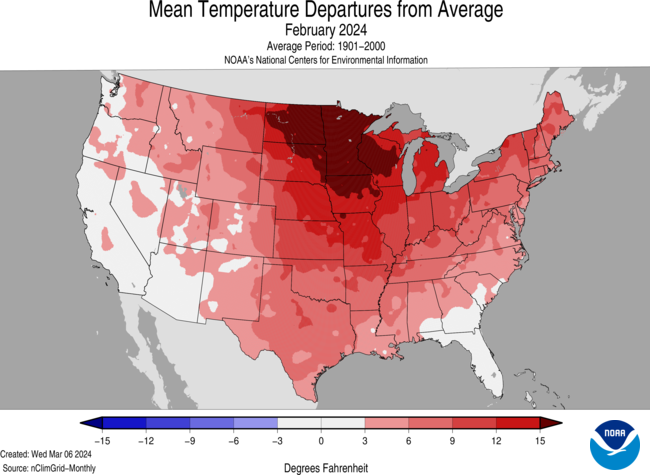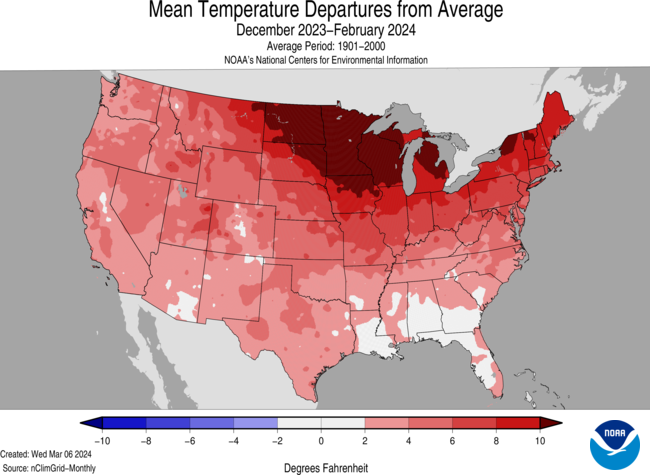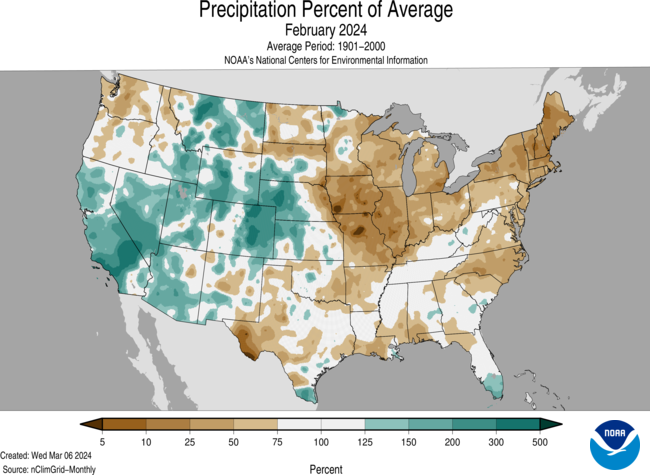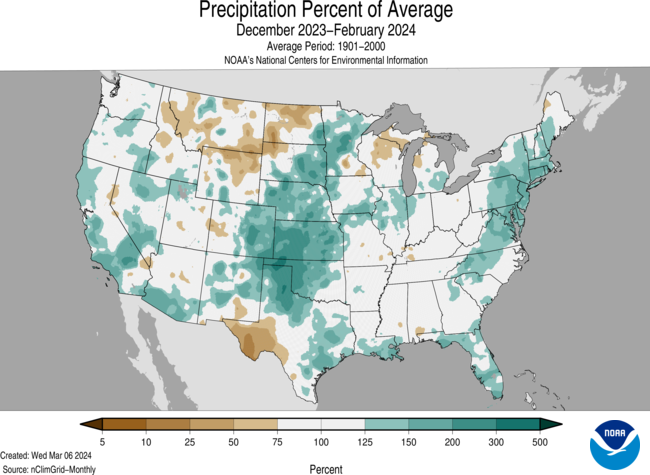Post by Benfxmth on Mar 8, 2024 17:09:19 GMT -5
Warmest winter on record for the U.S.
Warmest winter on record for the contiguous U.S. and a record wildfire claims more than a million acres in the southern Plains

Courtesy of Canva.com
Key Points:
The 2023–24 winter season ranked warmest on record for the contiguous U.S. with eight states across the Upper Midwest, Great Lakes and Northeast each observing their warmest winter on record.
The Smokehouse Creek wildfire burned more than a million acres in the Texas Panhandle and western Oklahoma. The wildfire began on February 26 and has become the largest wildfire in Texas history.
February 2024 was the third-warmest February on record for the nation and precipitation ranked in the driest third of the historical record for the month.
Other Highlights:
Temperature

Map of the U.S. showing temperature departure from average for February 2024 with warmer areas in gradients of red and cooler areas in gradients of blue.
The average temperature of the contiguous U.S. in February was 41.1°F, 7.2°F above average, ranking third warmest in the 130-year record. February temperatures were above average across most of the contiguous U.S., while record-warm temperatures were observed across much of the Mississippi Valley and in parts of the Great Lakes and southern Plains. Minnesota, Wisconsin, Iowa and Missouri each had their warmest February on record.
The Alaska statewide February temperature was 10.3°F, 5.5°F above the long-term average, ranking in the warmest third of the 100-year period of record for the state. Above-normal temperatures were observed across much of the state with near-normal temperatures observed in parts of southeast Alaska and Panhandle.
Map of the U.S. showing temperature departure from average for December 2023 through February 2024 with warmer areas in gradients of red and cooler areas in gradients of blue.

The meteorological winter (December–February) average temperature for the Lower 48 was 37.6°F, 5.4°F above average, ranking as the warmest winter on record. Temperatures were above average across a vast majority of the contiguous U.S. and near average along parts of the Gulf of Mexico. North Dakota, Minnesota, Iowa, Wisconsin, Michigan, New York, Vermont and New Hampshire each had their warmest winter on record.
The Alaska winter temperature was 6.4°F, 2.8°F above the long-term average, ranking in the middle third of the historical record for the state. Temperatures were above average across parts of the North Slope, West Coast, Southwest and Panhandle, while much of the Interior and south-central Alaska were near average for the season.
Precipitation

Map of the U.S. showing precipitation percent of average for February 2024 with wetter areas in gradients of green and drier areas in gradients of brown.
February precipitation for the contiguous U.S. was 1.86 inches, 0.27 inch below average, ranking in the driest third of the historical record. Precipitation was above average across much of the western U.S. and in parts of the central Appalachians, Southeast, and western High Plains. Conversely, precipitation was below normal across much of the eastern half of the U.S. and in parts of the Northwest, northern Plains and Southwest. Maine, New Hampshire, Vermont, New York and Illinois each had their second-driest February on record.
Alaska’s average monthly precipitation ranked in the middle third of the historical record. Precipitation was above average in parts of the North Slope, West Coast and in parts of the south-central Gulf of Alaska coast, while below-normal precipitation was observed in parts of the northeast Interior and Panhandle during the month.

Map of the U.S. showing precipitation percent of normal for December 2023 through February 2024 with wetter areas in gradients of green and drier areas in gradients of brown.
The U.S. winter precipitation total was 7.71 inches, 0.92 inch above average, ranking in the wettest third of the December–February record. Precipitation was above average across much of the contiguous U.S., while below-normal precipitation was observed along the Northern Tier and in parts of the Great Lakes and Southwest, and in small pockets of the Mississippi Valley and Maine. Connecticut and Delaware both had their third-wettest winter season on record.
For the winter season, precipitation ranked in the wettest third of the historical record for Alaska. Wetter-than-average conditions were observed across much of the state, while near-normal precipitation was observed in portions of the central Interior, south-central Interior and in parts of the Aleutians. Parts of the northeast Interior observed below-normal precipitation during this period.
Billion-Dollar Disasters
One new billion-dollar weather and climate disaster was confirmed in February 2024, as a January 8–10 southern tornado outbreak and east coast storm impacted more than a dozen states.
The U.S. has sustained 377 separate weather and climate disasters since 1980 where overall damages/costs reached or exceeded $1 billion (including CPI adjustment to 2024). The total cost of these 377 events exceeds $2.67 trillion.
Other Notable Events
A series of atmospheric river events brought heavy rain and snow to parts of the West during February, causing significant flooding, powerful winds, landslides and power outages in parts of California. The city of Los Angeles received more than 12 inches of rain during February, approximately three times the February average, becoming the wettest February in decades for the city.
Persistent warmth, with monthly temperature nearly 20°F above normal for the month, resulted in a steady decrease in ice coverage across the Great Lakes, which reached a historical low of 2.7% on February 11—the lowest ice coverage on record during mid February.
Unseasonably warm temperatures mixed with a vigorous cold front to fuel powerful storms in portions of the Upper Midwest that spawned tornadoes in Iowa and Illinois. Wisconsin had its first February tornado on record—an EF-2 near Evansville, Wisconsin.
Drought
According to the February 27 U.S. Drought Monitor report, about 21.6% of the contiguous U.S. was in drought, down about 2% from the end of January. Drought conditions expanded or intensified along portions of the Northern Tier, and in parts of the central and northern Mississippi Valley, southern Plains, the Carolinas and Hawaii this month. Drought contracted or was reduced in intensity across much of the Southwest and Lower Mississippi Valley, and parts of the central Plains, northern Rockies and Puerto Rico.
Monthly Outlook
Above-average temperatures are favored to impact much of the eastern U.S. in March while precipitation is likely from the central Plains to the West Coast and from the Gulf of Mexico to southern portions of New England. Drought is likely to persist along portions of the Northern Tier, Southwest, Hawaii and Puerto Rico. Visit the Climate Prediction Center’s Official 30-Day Forecasts and U.S. Monthly Drought Outlook website for more details.
Significant wildland fire potential for March is above normal across much of the Upper Midwest and in parts of the central and southern Plains. For additional information on wildland fire potential, visit the National Interagency Fire Center’s One-Month Wildland Fire Outlook.
This monthly summary from NOAA’s National Centers for Environmental Information is part of the suite of climate services NOAA provides to government, business, academia and the public to support informed decision-making. For more detailed climate information, check out our comprehensive February 2024 U.S. Climate Report scheduled for release on March 13, 2024. For additional information on the statistics provided here, visit the Climate at a Glance and National Maps webpages.
www.ncei.noaa.gov/news/national-climate-202402
Warmest winter on record for the contiguous U.S. and a record wildfire claims more than a million acres in the southern Plains

Courtesy of Canva.com
Key Points:
The 2023–24 winter season ranked warmest on record for the contiguous U.S. with eight states across the Upper Midwest, Great Lakes and Northeast each observing their warmest winter on record.
The Smokehouse Creek wildfire burned more than a million acres in the Texas Panhandle and western Oklahoma. The wildfire began on February 26 and has become the largest wildfire in Texas history.
February 2024 was the third-warmest February on record for the nation and precipitation ranked in the driest third of the historical record for the month.
Other Highlights:
Temperature

Map of the U.S. showing temperature departure from average for February 2024 with warmer areas in gradients of red and cooler areas in gradients of blue.
The average temperature of the contiguous U.S. in February was 41.1°F, 7.2°F above average, ranking third warmest in the 130-year record. February temperatures were above average across most of the contiguous U.S., while record-warm temperatures were observed across much of the Mississippi Valley and in parts of the Great Lakes and southern Plains. Minnesota, Wisconsin, Iowa and Missouri each had their warmest February on record.
The Alaska statewide February temperature was 10.3°F, 5.5°F above the long-term average, ranking in the warmest third of the 100-year period of record for the state. Above-normal temperatures were observed across much of the state with near-normal temperatures observed in parts of southeast Alaska and Panhandle.
Map of the U.S. showing temperature departure from average for December 2023 through February 2024 with warmer areas in gradients of red and cooler areas in gradients of blue.

The meteorological winter (December–February) average temperature for the Lower 48 was 37.6°F, 5.4°F above average, ranking as the warmest winter on record. Temperatures were above average across a vast majority of the contiguous U.S. and near average along parts of the Gulf of Mexico. North Dakota, Minnesota, Iowa, Wisconsin, Michigan, New York, Vermont and New Hampshire each had their warmest winter on record.
The Alaska winter temperature was 6.4°F, 2.8°F above the long-term average, ranking in the middle third of the historical record for the state. Temperatures were above average across parts of the North Slope, West Coast, Southwest and Panhandle, while much of the Interior and south-central Alaska were near average for the season.
Precipitation

Map of the U.S. showing precipitation percent of average for February 2024 with wetter areas in gradients of green and drier areas in gradients of brown.
February precipitation for the contiguous U.S. was 1.86 inches, 0.27 inch below average, ranking in the driest third of the historical record. Precipitation was above average across much of the western U.S. and in parts of the central Appalachians, Southeast, and western High Plains. Conversely, precipitation was below normal across much of the eastern half of the U.S. and in parts of the Northwest, northern Plains and Southwest. Maine, New Hampshire, Vermont, New York and Illinois each had their second-driest February on record.
Alaska’s average monthly precipitation ranked in the middle third of the historical record. Precipitation was above average in parts of the North Slope, West Coast and in parts of the south-central Gulf of Alaska coast, while below-normal precipitation was observed in parts of the northeast Interior and Panhandle during the month.

Map of the U.S. showing precipitation percent of normal for December 2023 through February 2024 with wetter areas in gradients of green and drier areas in gradients of brown.
The U.S. winter precipitation total was 7.71 inches, 0.92 inch above average, ranking in the wettest third of the December–February record. Precipitation was above average across much of the contiguous U.S., while below-normal precipitation was observed along the Northern Tier and in parts of the Great Lakes and Southwest, and in small pockets of the Mississippi Valley and Maine. Connecticut and Delaware both had their third-wettest winter season on record.
For the winter season, precipitation ranked in the wettest third of the historical record for Alaska. Wetter-than-average conditions were observed across much of the state, while near-normal precipitation was observed in portions of the central Interior, south-central Interior and in parts of the Aleutians. Parts of the northeast Interior observed below-normal precipitation during this period.
Billion-Dollar Disasters
One new billion-dollar weather and climate disaster was confirmed in February 2024, as a January 8–10 southern tornado outbreak and east coast storm impacted more than a dozen states.
The U.S. has sustained 377 separate weather and climate disasters since 1980 where overall damages/costs reached or exceeded $1 billion (including CPI adjustment to 2024). The total cost of these 377 events exceeds $2.67 trillion.
Other Notable Events
A series of atmospheric river events brought heavy rain and snow to parts of the West during February, causing significant flooding, powerful winds, landslides and power outages in parts of California. The city of Los Angeles received more than 12 inches of rain during February, approximately three times the February average, becoming the wettest February in decades for the city.
Persistent warmth, with monthly temperature nearly 20°F above normal for the month, resulted in a steady decrease in ice coverage across the Great Lakes, which reached a historical low of 2.7% on February 11—the lowest ice coverage on record during mid February.
Unseasonably warm temperatures mixed with a vigorous cold front to fuel powerful storms in portions of the Upper Midwest that spawned tornadoes in Iowa and Illinois. Wisconsin had its first February tornado on record—an EF-2 near Evansville, Wisconsin.
Drought
According to the February 27 U.S. Drought Monitor report, about 21.6% of the contiguous U.S. was in drought, down about 2% from the end of January. Drought conditions expanded or intensified along portions of the Northern Tier, and in parts of the central and northern Mississippi Valley, southern Plains, the Carolinas and Hawaii this month. Drought contracted or was reduced in intensity across much of the Southwest and Lower Mississippi Valley, and parts of the central Plains, northern Rockies and Puerto Rico.
Monthly Outlook
Above-average temperatures are favored to impact much of the eastern U.S. in March while precipitation is likely from the central Plains to the West Coast and from the Gulf of Mexico to southern portions of New England. Drought is likely to persist along portions of the Northern Tier, Southwest, Hawaii and Puerto Rico. Visit the Climate Prediction Center’s Official 30-Day Forecasts and U.S. Monthly Drought Outlook website for more details.
Significant wildland fire potential for March is above normal across much of the Upper Midwest and in parts of the central and southern Plains. For additional information on wildland fire potential, visit the National Interagency Fire Center’s One-Month Wildland Fire Outlook.
This monthly summary from NOAA’s National Centers for Environmental Information is part of the suite of climate services NOAA provides to government, business, academia and the public to support informed decision-making. For more detailed climate information, check out our comprehensive February 2024 U.S. Climate Report scheduled for release on March 13, 2024. For additional information on the statistics provided here, visit the Climate at a Glance and National Maps webpages.
www.ncei.noaa.gov/news/national-climate-202402



